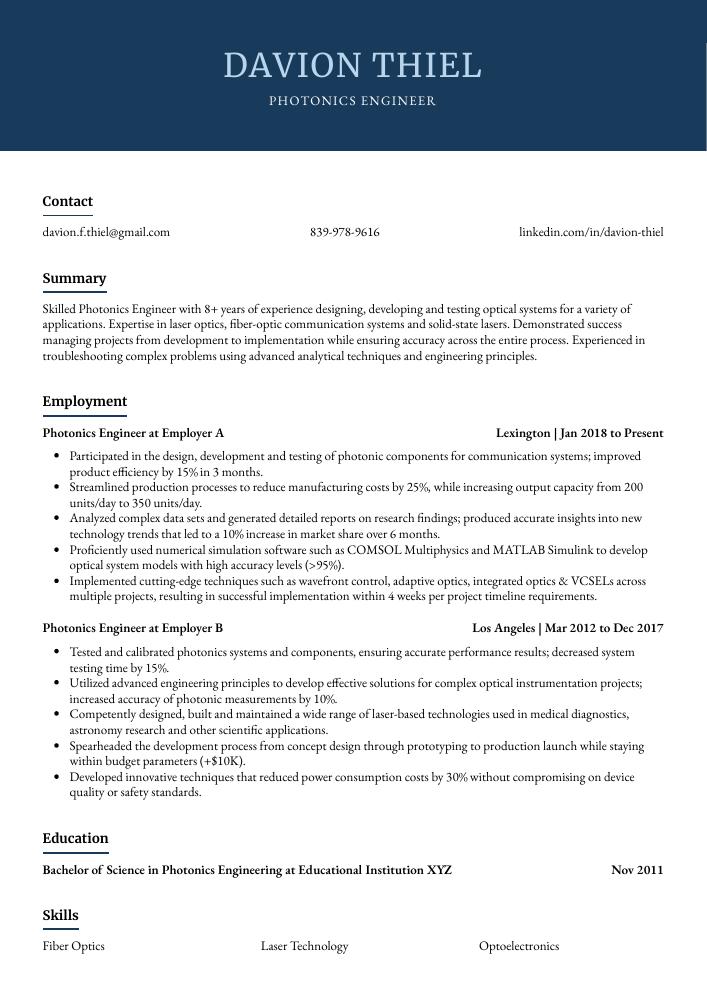Photonics Engineer Resume Guide
Photonics Engineers design, develop and test optical components, systems and networks. They use their knowledge of optics to research new technologies, investigate the performance of existing devices and optimize designs for improved efficiency. They also provide technical support to customers who are using photonic products.
Your experience in photonics engineering could be a great asset to any company. To make sure employers are aware of your skills, you must write an impressive resume that will capture their attention and curiosity.
This guide will walk you through the entire process of creating a top-notch resume. We first show you a complete example and then break down what each resume section should look like.
Table of Contents
The guide is divided into sections for your convenience. You can read it from beginning to end or use the table of contents below to jump to a specific part.
Photonics Engineer Resume Sample
Davion Thiel
Photonics Engineer
[email protected]
839-978-9616
linkedin.com/in/davion-thiel
Summary
Skilled Photonics Engineer with 8+ years of experience designing, developing and testing optical systems for a variety of applications. Expertise in laser optics, fiber-optic communication systems and solid-state lasers. Demonstrated success managing projects from development to implementation while ensuring accuracy across the entire process. Experienced in troubleshooting complex problems using advanced analytical techniques and engineering principles.
Experience
Photonics Engineer, Employer A
Lexington, Jan 2018 – Present
- Participated in the design, development and testing of photonic components for communication systems; improved product efficiency by 15% in 3 months.
- Streamlined production processes to reduce manufacturing costs by 25%, while increasing output capacity from 200 units/day to 350 units/day.
- Analyzed complex data sets and generated detailed reports on research findings; produced accurate insights into new technology trends that led to a 10% increase in market share over 6 months.
- Proficiently used numerical simulation software such as COMSOL Multiphysics and MATLAB Simulink to develop optical system models with high accuracy levels (>95%).
- Implemented cutting-edge techniques such as wavefront control, adaptive optics, integrated optics & VCSELs across multiple projects, resulting in successful implementation within 4 weeks per project timeline requirements.
Photonics Engineer, Employer B
Los Angeles, Mar 2012 – Dec 2017
- Tested and calibrated photonics systems and components, ensuring accurate performance results; decreased system testing time by 15%.
- Utilized advanced engineering principles to develop effective solutions for complex optical instrumentation projects; increased accuracy of photonic measurements by 10%.
- Competently designed, built and maintained a wide range of laser-based technologies used in medical diagnostics, astronomy research and other scientific applications.
- Spearheaded the development process from concept design through prototyping to production launch while staying within budget parameters (+$10K).
- Developed innovative techniques that reduced power consumption costs by 30% without compromising on device quality or safety standards.
Skills
- Fiber Optics
- Laser Technology
- Optoelectronics
- Optical Communications
- Photonic Devices
- Photonic Materials
- Photonic Systems
- Optics and Photonics
- Photonic Integration
Education
Bachelor of Science in Photonics Engineering
Educational Institution XYZ
Nov 2011
Certifications
Certified Photonics Professional (CPP)
The International Society for
May 2017
1. Summary / Objective
A resume summary for a photonics engineer should give the hiring manager an overview of your skills and experience. Include details such as the types of lasers you have worked with, any certifications or awards you may have received, and how many years’ experience you possess in this field. You could also mention some key projects that demonstrate your technical proficiency in optics engineering.
Below are some resume summary examples:
Talented and highly motivated Photonics Engineer with a passion for developing cutting-edge optical systems. Proven expertise in the design, fabrication, and testing of complex photonic devices used in telecommunications and medical imaging applications. Seeking to bring 5+ years’ experience to ABC Technologies where I can leverage my knowledge of lasers, optics, semiconductors physics & materials science to drive innovation.
Diligent and creative photonics engineer with 5+ years of experience developing, implementing and troubleshooting complex optical systems for various applications. At ABC, designed a novel laser-based system that achieved groundbreaking results in the medical field; successfully led multiple projects from concept to delivery. Skilled at working with diverse instruments such as lasers, cameras, imaging devices and more.
Driven Photonics Engineer with 8 years of experience designing and developing innovative laser systems for medical, industrial, and research applications. Proven track record in leading cross-functional teams to deliver high-performance projects on time and under budget. Seeking to join ABC Technologies as a Photonics Engineer where I can apply my knowledge of optics principles, lasers, detectors and optical materials.
Proficient photonics engineer with 7+ years of experience developing and testing photonic components for industrial, medical, and consumer applications. Skilled in utilizing advanced optics modeling software to design functional optical systems that meet customer specifications. Seeking to join ABC Tech as a Photonics Engineer where I can leverage my expertise in light-based technologies to help increase efficiency.
Dependable and creative photonics engineer with 7+ years of experience in design, development and testing. Achieved a significant reduction in project costs by using innovative solutions to complex problems. At XYZ Inc., developed new methods for improving the performance of laser systems while reducing production costs by 15%. Experienced in working on multi-disciplinary teams to develop industry-leading products.
Accomplished photonics engineer with 8+ years of experience in designing, developing and implementing optical systems for various industry sectors. At ABC, designed a high-precision laser system that resulted in 40% cost savings over existing designs. Proven track record of successfully managing complex projects on time and within budget while maintaining the highest standards of quality assurance.
Seasoned photonics engineer with 10+ years of experience in designing, testing, and troubleshooting optical systems for a variety of applications. Adept at developing complex algorithms to model physical phenomena and constructing custom components from scratch. Highly motivated to join ABC Technologies and apply my expertise in the field of photonics engineering.
Detail-oriented photonics engineer with 5+ years of experience in designing, developing, and testing optical systems. Skilled at using a variety of software tools to create high-performance products for defense applications. Looking to join ABC Technologies where I can utilize my expertise in optics research and system integration to develop innovative solutions.
2. Experience / Employment
The work history/experience section is where you provide details on your past roles. This should be written in reverse chronological order, meaning the most recent job is listed first.
When writing this section, it’s best to stick with bullet points so that the reader can quickly digest what you have to say. You want to take some time to think about the specifics of what you did and how successful your efforts were.
For example, instead of saying “Designed photonics systems,” you could say, “Developed 3D models for a range of optical components using CAD software; resulted in an 8% reduction in overall system cost.”
To write effective bullet points, begin with a strong verb or adverb. Industry specific verbs to use are:
- Designed
- Fabricated
- Analyzed
- Optimized
- Programmed
- Simulated
- Installed
- Calibrated
- Troubleshot
- Assembled
- Tested
- Monitored
- Documented
- Implemented
- Operated
Other general verbs you can use are:
- Achieved
- Advised
- Assessed
- Compiled
- Coordinated
- Demonstrated
- Developed
- Expedited
- Facilitated
- Formulated
- Improved
- Introduced
- Mentored
- Participated
- Prepared
- Presented
- Reduced
- Reorganized
- Represented
- Revised
- Spearheaded
- Streamlined
- Structured
- Utilized
Below are some example bullet points:
- Meticulously designed, tested and implemented numerous photonic systems to improve the performance of existing products; reduced development time by 15%.
- Operated sophisticated laser equipment to measure optical parameters in accordance with company specifications while ensuring compliance with safety regulations.
- Represented the organization at international conferences, presenting cutting-edge research projects related to photonics engineering before audiences of up to 250 people.
- Programmed software for different types of imaging systems used in various scientific experiments; wrote over 100 lines of code across 4 programming languages during a 3 month period resulting in faster data acquisition times (+30%).
- Compiled weekly progress reports on complex photonics design projects, detailing successes and areas needing improvement; identified cost savings opportunities totalling $10K within 6 months’ time frame leading to increased efficiency & productivity levels across departments.
- Diligently designed, developed and tested high-precision photonics equipment for a variety of applications; improved the accuracy of product measurements by 8%.
- Documented technical specifications, design details and test results in reports to ensure traceability throughout the development process.
- Introduced cutting-edge technologies such as advanced optical sensors and computer vision systems into existing projects; increased operational efficiency by 15% over 3 months.
- Prepared detailed presentations on new products for internal stakeholders with visuals & animations; completed 2 successful sales pitches that secured $500K worth of additional funds from investors within 6 weeks.
- Presented research findings at industry conferences related to laser optics & electro-optical engineering, leading to an increase in customer inquiries about our services by 25%.
- Mentored 3 junior engineers, providing guidance in photonics design and troubleshooting; improved their technical proficiency by 60%.
- Structured a new system of laser testing procedures to ensure accuracy of results, resulting in 10% higher efficiency for the department.
- Troubleshot complex optical systems problems and identified solutions that saved $15K in maintenance costs over an 8-month period.
- Actively monitored the performance parameters of various lasers using specialized equipment and software; optimized operations to meet customer needs within 2 hours on average per job order.
- Reorganized existing processes related to laboratory instrumentation with minimal disruption; increased throughput capacity by 30% without additional staffing or resources allocated from other departments.
- Fabricated photonics equipment such as lasers, optical fibers and waveguides to meet customer specifications while adhering to all safety protocols; decreased overall production time by 25%.
- Installed photonic components in existing systems with accuracy and precision, completing projects ahead of schedule on numerous occasions resulting in $10K+ savings for the company.
- Designed new laser modules using advanced CAD software that reduced power consumption levels by 40% when compared to previous versions.
- Simulated different light-matter interactions using COMSOL Multiphysics tools; achieved a 20% improvement in design quality within 4 months of joining the team.
- Substantially improved system performance through regular maintenance checks and calibration efforts, leading to an increase in efficiency across multiple applications by 30%.
- Improved the efficiency of laser systems by 15% through design and implementation of photonics engineering solutions.
- Successfully developed a new range of micro-optics components, resulting in an overall increase in customer satisfaction ratings by 20%.
- Facilitated the testing process for all optics projects, ensuring that quality control standards were met within tight deadlines and budgets; reduced testing time per project from 10 hours to 8 hours on average.
- Developed prototypes for novel optical imaging systems which significantly enhanced resolution capabilities compared with existing models (+50%).
- Demonstrated expertise when developing advanced light detectors incorporating cutting-edge technology such as quantum dots, leading to improved detector sensitivity levels (x20).
- Assembled and tested advanced optical systems and components with precision, achieving a 98% accuracy rate in all projects.
- Monitored the performance of photonic devices to ensure that they met design specifications; detected and resolved any malfunctions within 24 hours.
- Reliably designed 30+ electrical circuits for use in fiber-optic communication systems, leading to improved signal quality and increased throughput by 25%.
- Coordinated between 15 stakeholders on various photonics engineering projects, liaising with vendors to deliver cost-effective solutions meeting tight deadlines every time.
- Assessed customer requirements accurately before designing customized photonic products; reduced production costs by 10% while providing superior services consistently over 6 months period.
- Advised senior management on the optimization of photonics prototypes, resulting in a 30% reduction in development costs.
- Expedited prototype design and testing processes by an average of 6 hours per project; increased production efficiency by 50%.
- Resourcefully identified new light sources for use with existing components, leading to improved performance and accuracy across various applications.
- Reduced energy consumption levels of optical systems through careful selection of lenses and other components, resulting in a 10% cost savings annually.
- Revised technical specifications based on customer feedback while maintaining compliance with industry regulations; successfully met all requirements within tight timelines without compromising quality standards or safety protocols.
- Efficiently designed and developed photonic components, utilizing 3D printing technology to reduce prototype development time by 25%.
- Achieved a cost savings rate of 10% when developing innovative photonics systems for multiple clients in the medical device industry; delivered projects on-time & within budget.
- Formulated strategies to optimize data transfer rates in optical networks which resulted in an increase of up to 15% compared with traditional methods.
- Optimized the performance characteristics of laser optics assemblies used for imaging applications, leading to improved resolution by 40%.
3. Skills
Skill requirements will differ from employer to employer – this can easily be determined via the job advert. Organization ABC may be looking for someone with experience in fiber optics while Organization XYZ may want a candidate who is proficient in laser technology.
It is important to tailor the skills section of your resume according to each job you are applying for because many employers use applicant tracking systems that scan resumes for certain keywords before passing them on to a human.
Once listed here, you can further discuss your qualifications and expertise by elaborating on it in other areas such as the summary or experience section.
Below is a list of common skills & terms:
- Fiber Optics
- Laser Technology
- Optical Communications
- Optics and Photonics
- Optoelectronics
- Photonic Devices
- Photonic Integration
- Photonic Materials
- Photonic Packaging
- Photonic Systems
4. Education
Mentioning an education section on your resume will depend on how far along you are in your career. If you just graduated and have no prior work experience, include an education section below your resume objective. However, if you have extensive professional experience as a photonics engineer, omitting the education section is perfectly fine.
If including an education section, try to mention courses related to the photonics engineering role that demonstrate knowledge of relevant topics such as optics and lasers.
Bachelor of Science in Photonics Engineering
Educational Institution XYZ
Nov 2011
5. Certifications
Certifications are a great way to demonstrate your knowledge and expertise in a particular field. They can also be used as proof that you have taken the time to stay up-to-date with industry trends and practices.
If you are applying for a job that requires specific certifications, make sure to include them on your resume so employers know what qualifications you possess. This will give them confidence in knowing that they are hiring someone who is knowledgeable about their profession.
Certified Photonics Professional (CPP)
The International Society for
May 2017
6. Contact Info
Your name should be the first thing a reader sees when viewing your resume, so ensure its positioning is prominent. Your phone number should be written in the most commonly used format in your country/city/state, and your email address should be professional.
You can also choose to include a link to your LinkedIn profile, personal website, or other online platforms relevant to your industry.
Finally, name your resume file appropriately to help hiring managers; for Davion Thiel, this would be Davion-Thiel-resume.pdf or Davion-Thiel-resume.docx.
7. Cover Letter
Including a cover letter with your job application is a great way to make yourself stand out from the competition. While resumes provide recruiters with an overview of your qualifications, cover letters enable you to explain why you’re the perfect fit for the position and highlight qualities that may not be immediately apparent on paper.
Cover letters typically consist of 2-4 paragraphs, separate from a resume. They give hiring managers more insight into who you are as an individual and allow them to get a better sense of what makes you unique compared to other applicants.
Below is an example cover letter:
Dear Aaron,
I am excited to apply for the Photonics Engineer position at [company name]. As a photonics engineer with 5+ years of experience in the design, development, and implementation of optical systems, I am confident I will be an asset to your organization.
In my previous role as a photonics engineer at [company name], I was responsible for designing and developing optical systems for military applications. My experience includes working with laser diodes, fiber optics, and optoelectronic devices. I have also designed and built prototypes of optical systems. In addition, I have experience troubleshooting optical system problems and providing technical support to customers.
Your listed requirements closely match my background and skills. A few highlights from my resume that would enable me to contribute to your bottom line are:
– Experience in designing and developing optical systems
– Experience with laser diodes, fiber optics, and optoelectronic devices
– Ability to design and build prototypes of optical systems
– Experience troubleshooting optical system problems
– Strong customer service skills
I’ve attached a copy of my resume detailing my projects and experience in the field of photonics engineering. If you have any questions or would like additional information about my qualifications, please do not hesitate to contact me via phone or email. Thank you for your time consideration; I look forward to speaking with you soon about this opportunity.
Sincerely,
Davion
Photonics Engineer Resume Templates
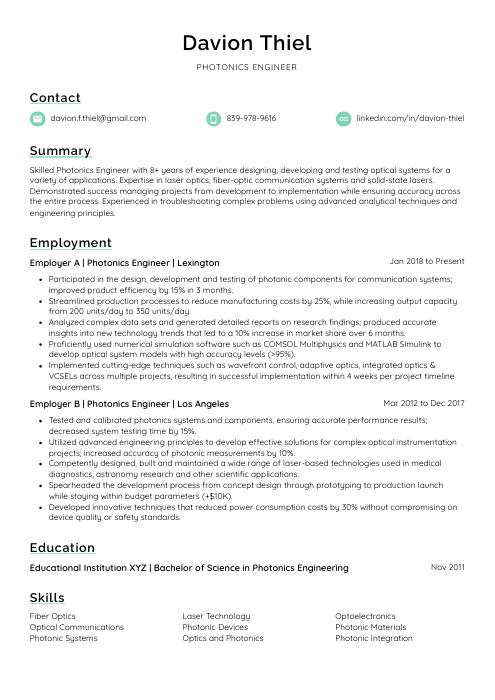 Lorikeet
Lorikeet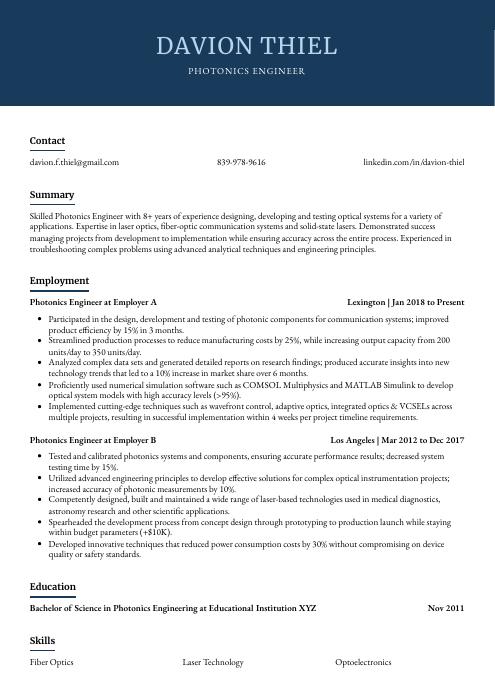 Bonobo
Bonobo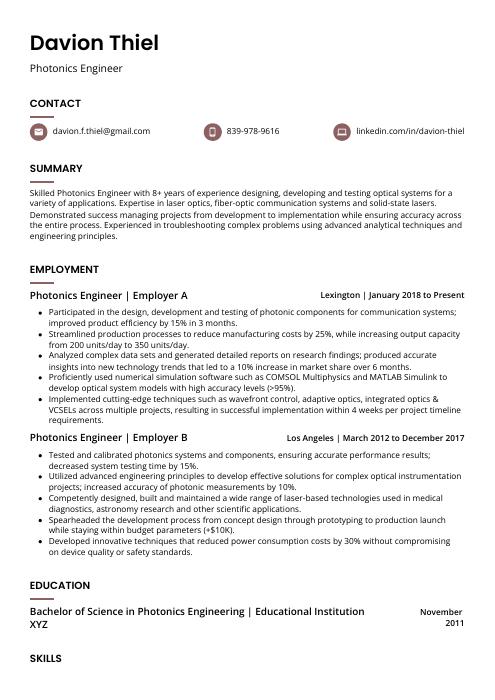 Fossa
Fossa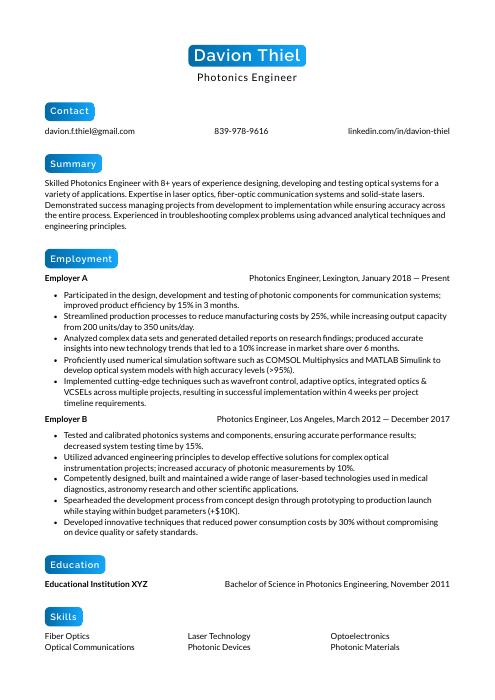 Kinkajou
Kinkajou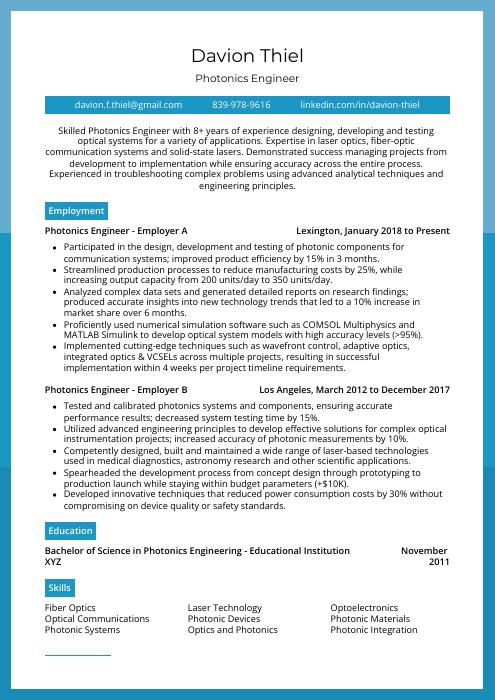 Rhea
Rhea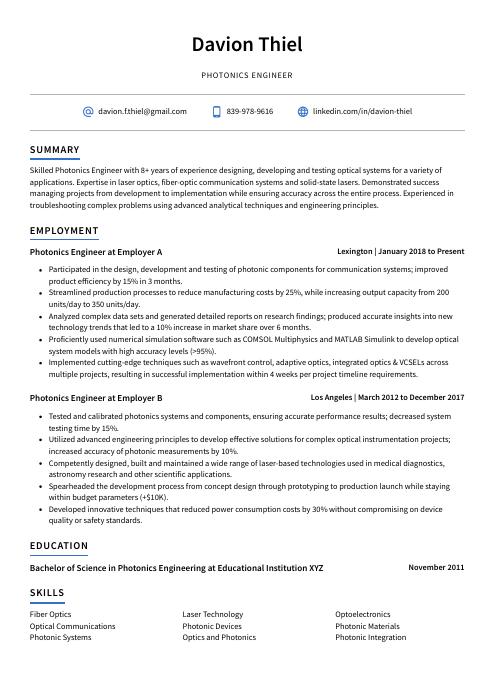 Axolotl
Axolotl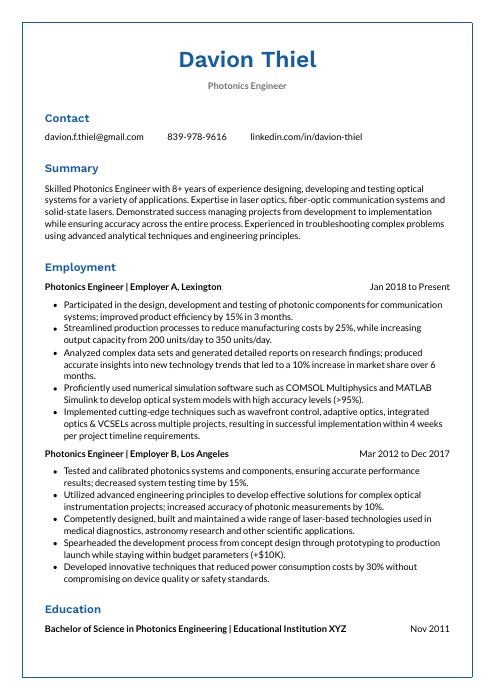 Markhor
Markhor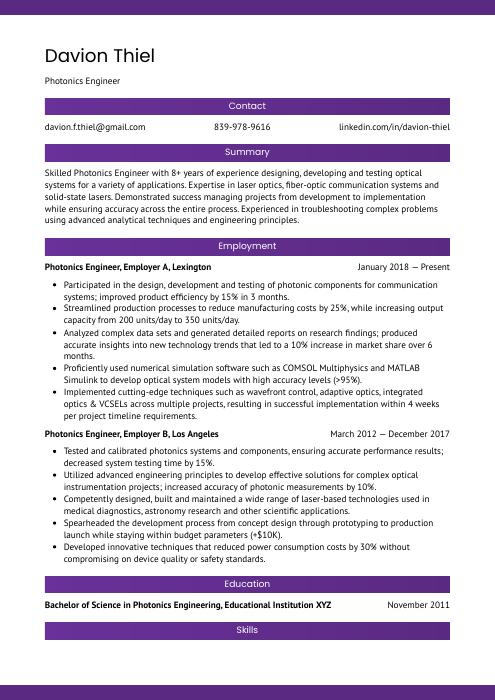 Jerboa
Jerboa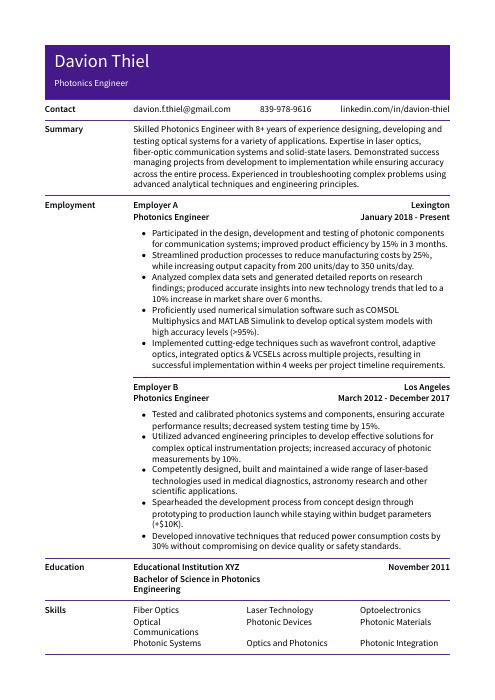 Pika
Pika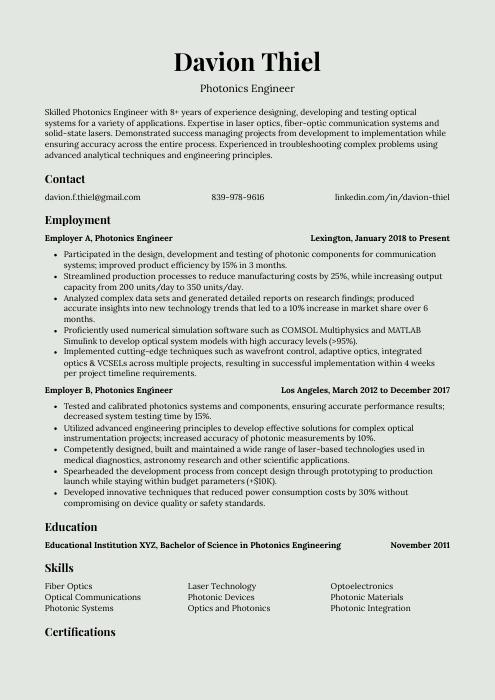 Saola
Saola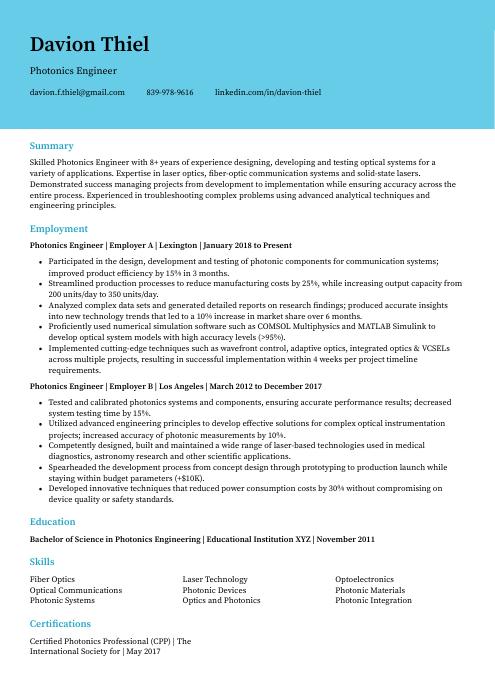 Dugong
Dugong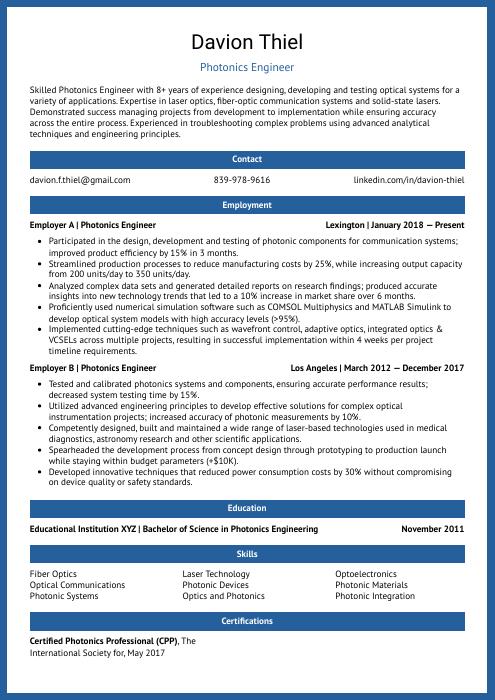 Ocelot
Ocelot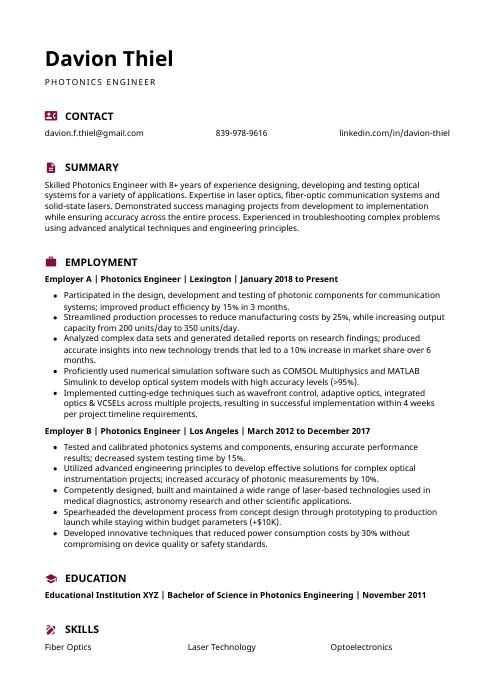 Hoopoe
Hoopoe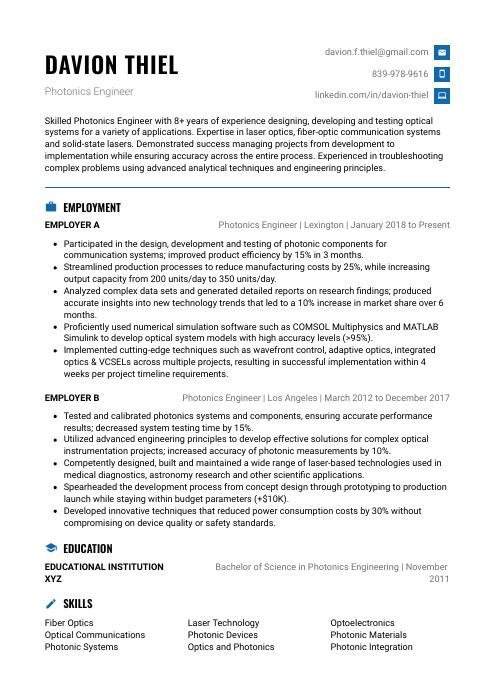 Echidna
Echidna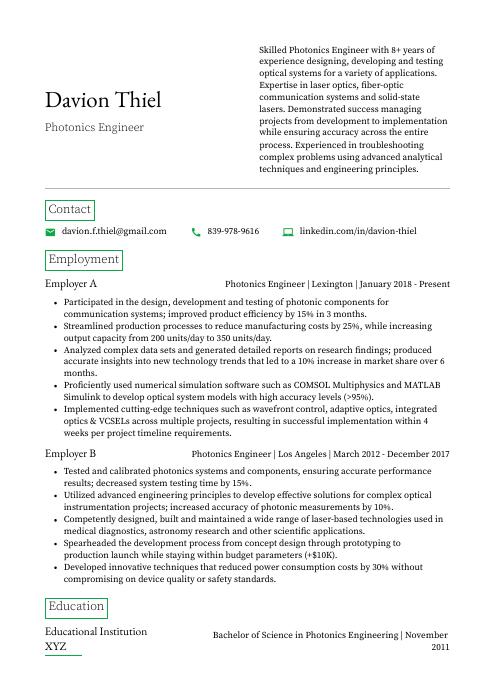 Quokka
Quokka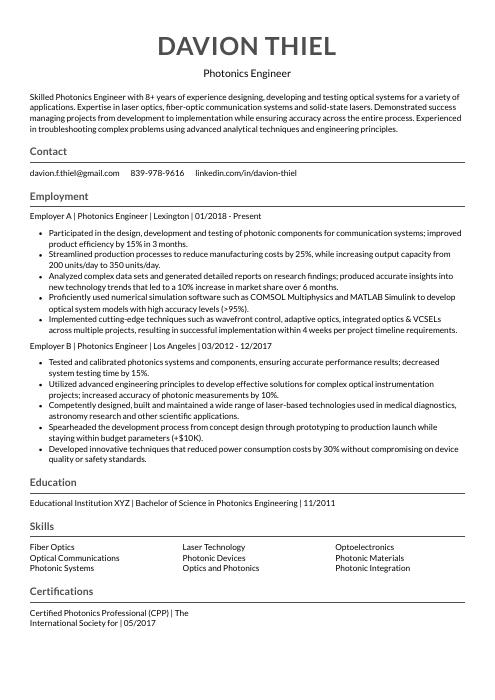 Indri
Indri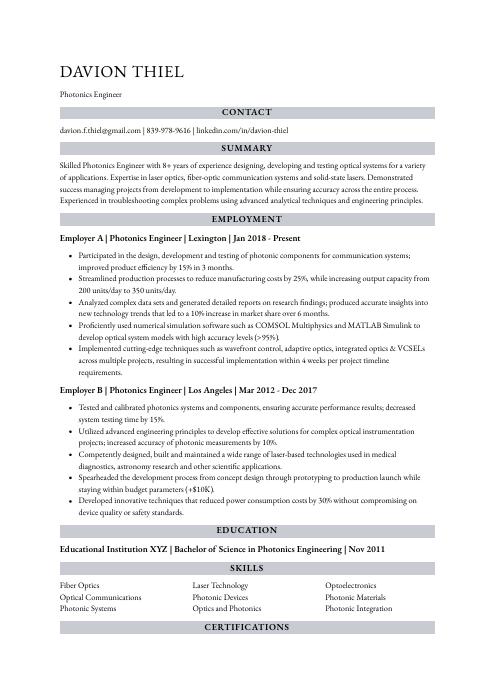 Numbat
Numbat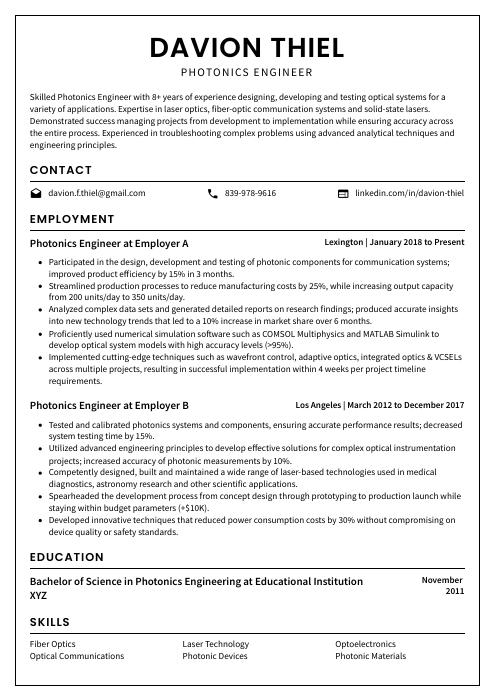 Cormorant
Cormorant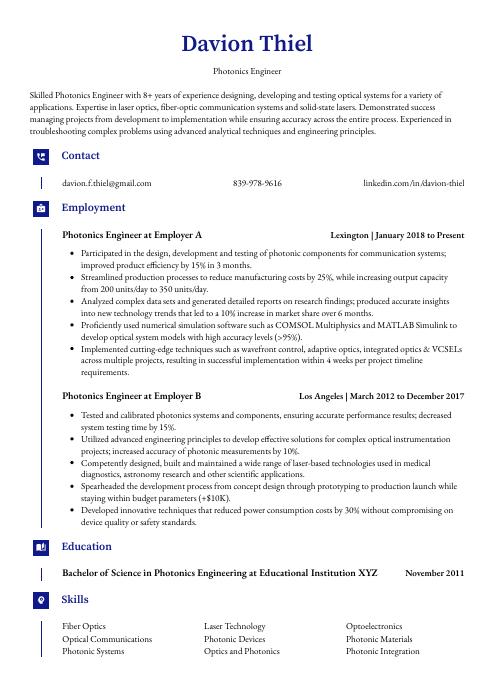 Gharial
Gharial Rezjumei
Rezjumei
